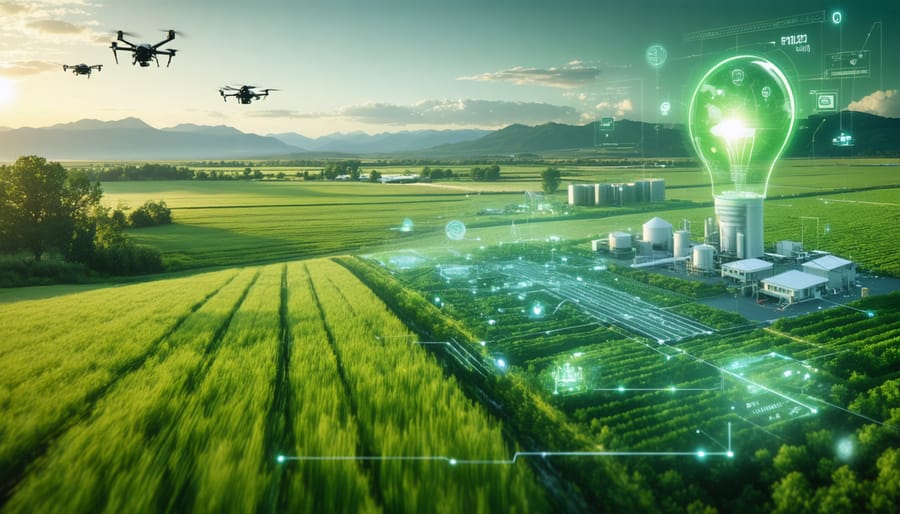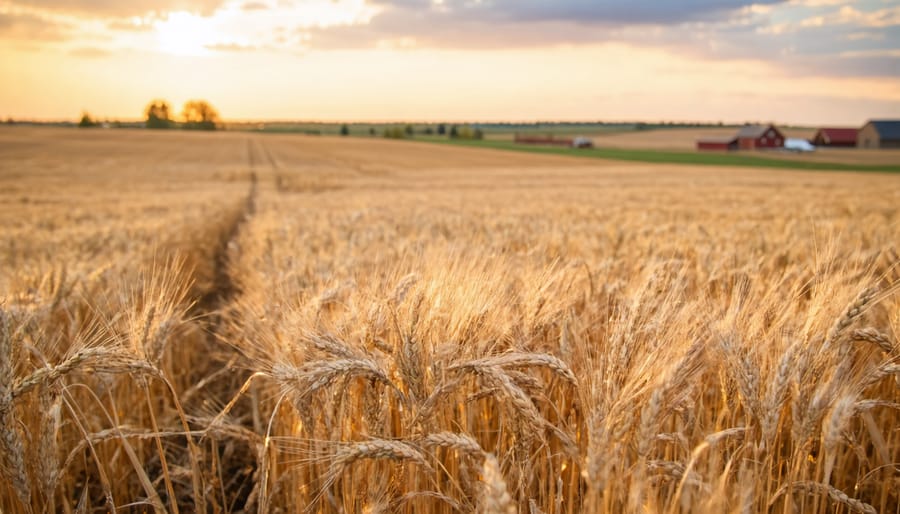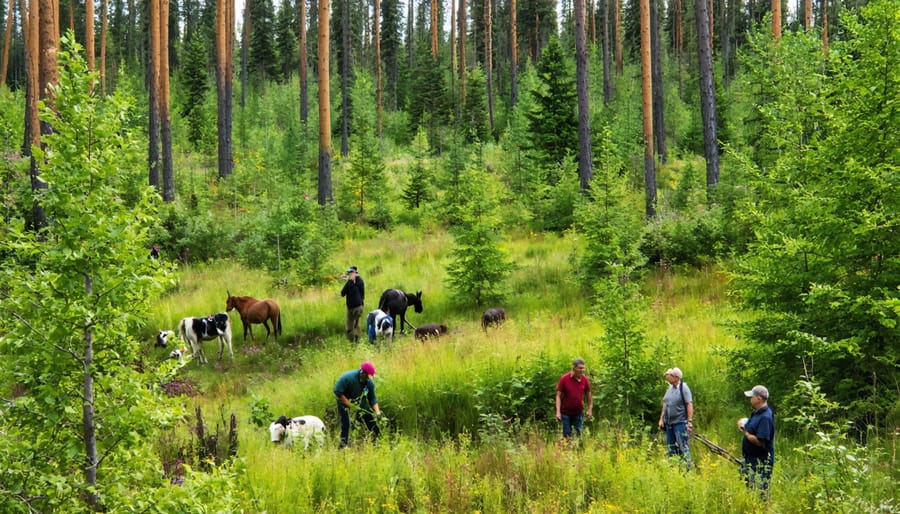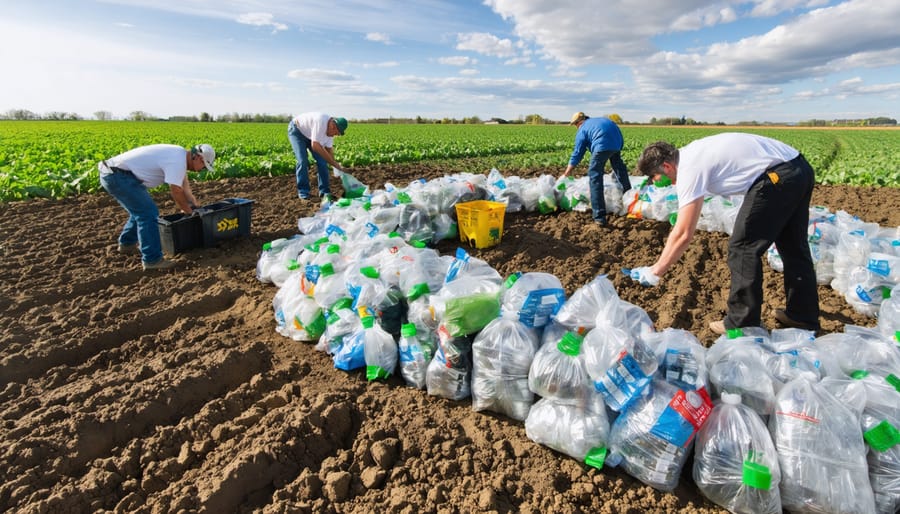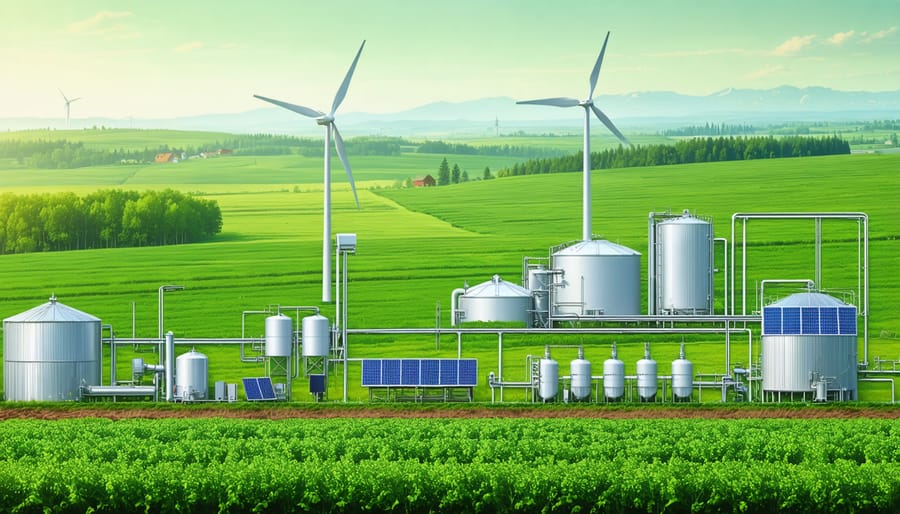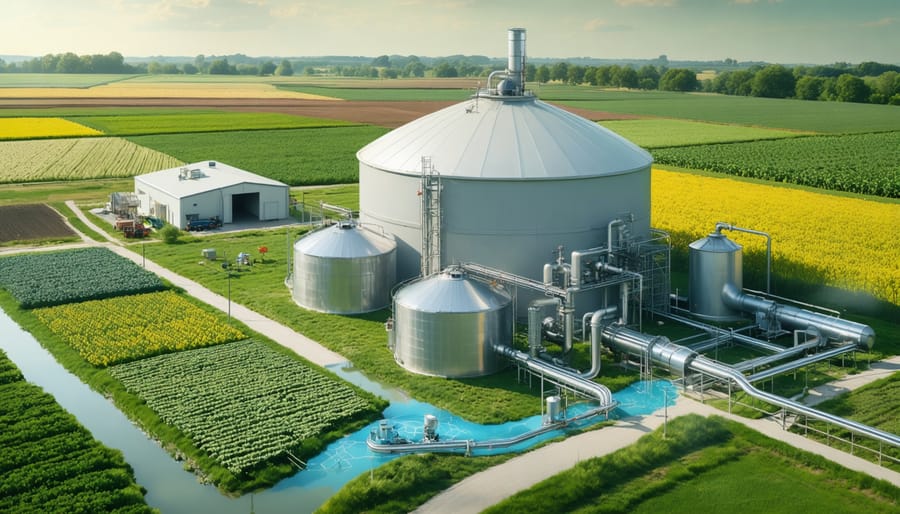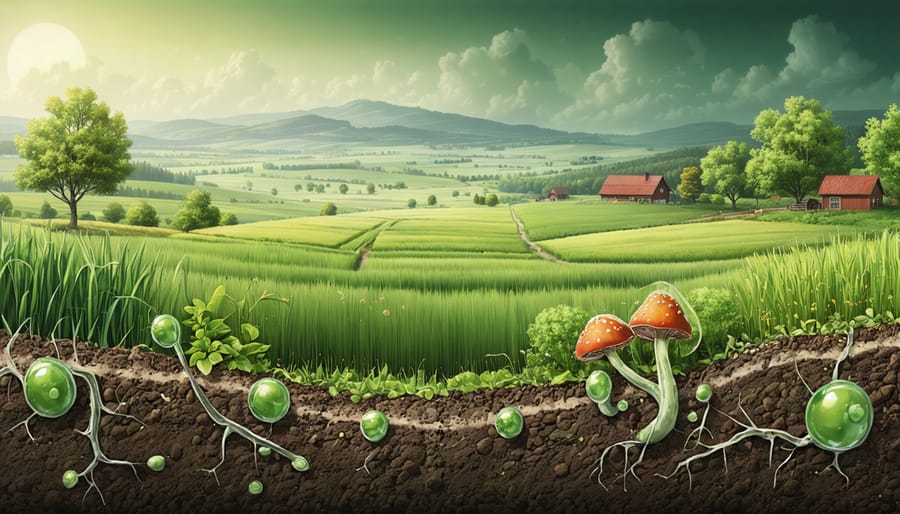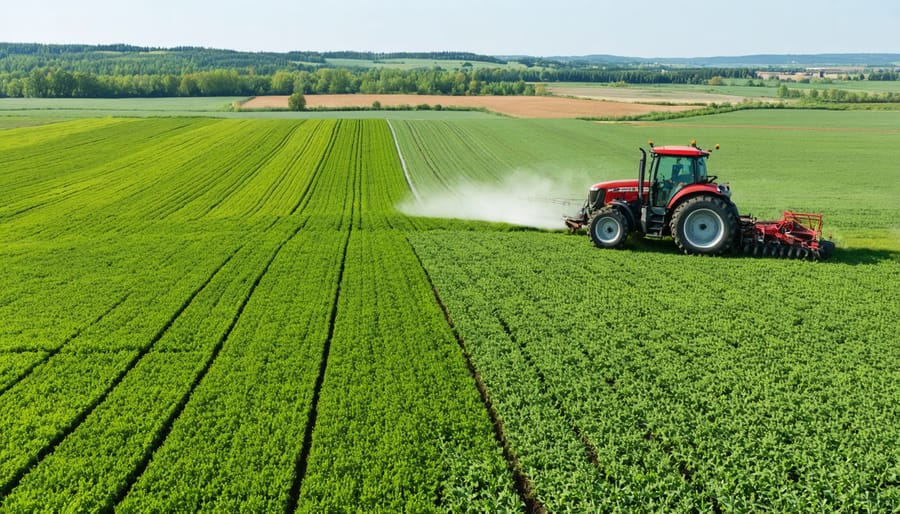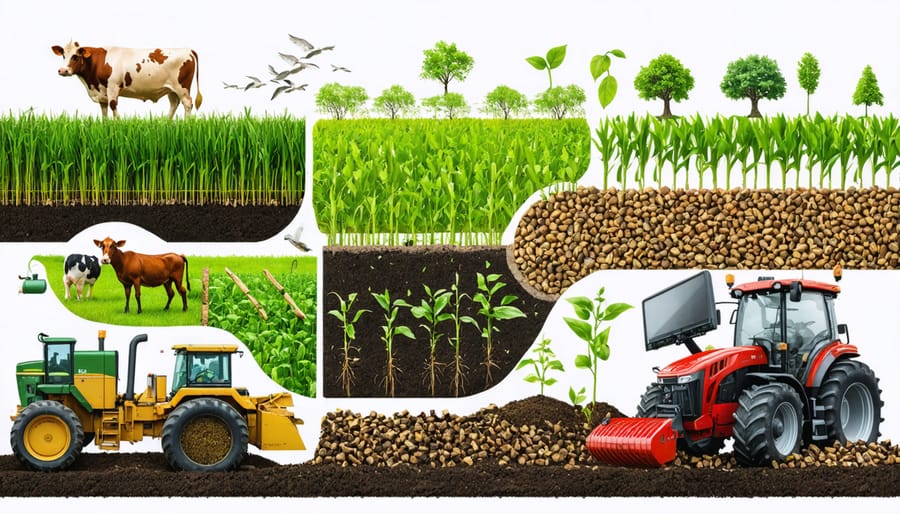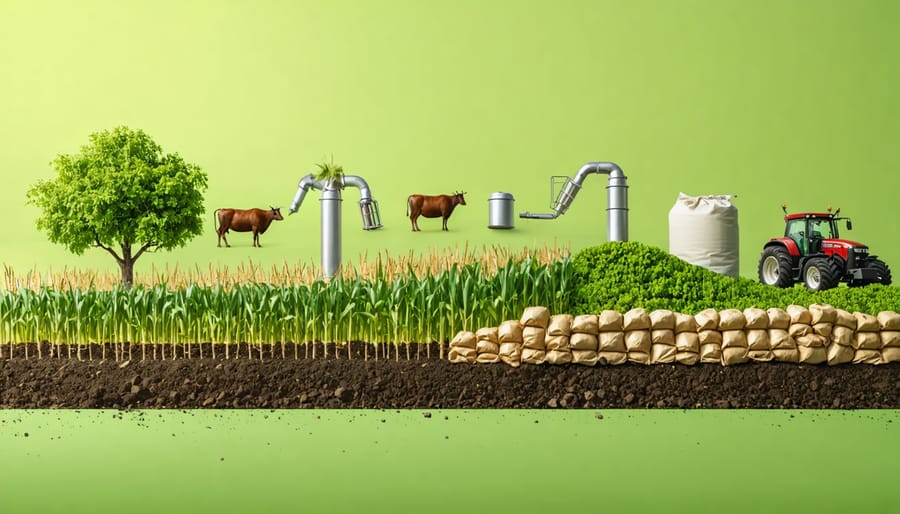Transform farm operations through groundbreaking agricultural waste management solutions and precision agriculture technologies reshaping Canadian farming. Vertical farming installations across Alberta now yield 15 times more produce per square metre while using 95% less water than traditional methods. Smart sensors and AI-driven irrigation systems reduce water consumption by 40% while increasing crop yields by 25% in drought-prone regions. Autonomous drones and robotics handle precise seeding, targeted pest control, and real-time crop monitoring, cutting labor costs by 30% and reducing pesticide use by half.
These innovations aren’t just transforming large operations – family farms across the Prairie provinces are adopting these technologies through equipment-sharing cooperatives and government-backed initiatives. With implementation costs dropping by 60% over the past three years and ROI averaging 18 months, these advanced farming methods are becoming increasingly accessible to operations of all sizes. The future of Canadian agriculture isn’t just about survival – it’s about pioneering sustainable practices that boost productivity while preserving our natural resources for generations to come.
Biogas Revolution: Transform Your Farm Waste into Energy

Alberta’s Success Story: The Miller Farm Biogas Project
Located just outside of Red Deer, the Miller Farm Biogas Project has become a shining example of sustainable agriculture in Alberta. In 2019, John and Sarah Miller transformed their 2,000-acre mixed farming operation by implementing a state-of-the-art biogas system that processes both agricultural waste and organic materials from nearby food processors.
The system, which cost $1.8 million to implement, now generates enough electricity to power 200 homes while providing heat for the farm’s operations. The Millers report annual energy cost savings of approximately $85,000, with additional revenue of $120,000 from selling excess electricity back to the grid.
“The initial investment seemed daunting,” says John Miller, “but the provincial grants covered 30% of the costs, and we reached our break-even point in just over four years.” The project now processes 15,000 tonnes of organic waste annually, significantly reducing the farm’s carbon footprint while creating valuable by-products like organic fertilizer.
The success has inspired neighboring farms to explore similar solutions. The Millers regularly host educational tours for local farmers and agricultural students, sharing their expertise and practical insights. Their project has become a model for agricultural innovation in Alberta, demonstrating how traditional farming operations can embrace renewable energy solutions while maintaining profitability.
The Miller Farm’s achievement has earned recognition from both environmental groups and agricultural associations, proving that sustainable practices and economic success can go hand in hand.
Getting Started with Biogas: Essential Equipment and Costs
Starting a biogas production system requires careful planning and initial investment, but many Alberta farmers find the returns well worth the effort. Essential equipment includes an anaerobic digester (ranging from $75,000 to $250,000), gas storage tanks, and a generator set for electricity production.
For a mid-sized farm processing 100 tonnes of organic waste annually, expect to invest between $200,000 and $400,000 in total setup costs. This typically includes:
– Primary digester tank
– Gas collection and storage system
– Mixing equipment
– Safety monitoring devices
– Connection to power grid
Most Alberta farmers recover their investment within 3-5 years through energy savings and revenue from excess power sales. Local success stories, like the Henderson Farm in Red Deer County, demonstrate annual savings of $45,000 in energy costs and additional income of $30,000 from power sales to the grid.
Government grants can significantly reduce initial costs. The Canadian Agricultural Clean Technology Program currently offers funding up to 50% of project costs for qualifying farms. Local agricultural cooperatives also provide shared equipment options, allowing smaller operations to benefit from biogas technology without bearing the full cost burden.
Remember to factor in annual maintenance costs of approximately 2-3% of the initial investment and consider working with experienced installers familiar with Alberta’s climate conditions.
Smart Composting Systems That Work in Alberta’s Climate
Automated Temperature Monitoring and Control
Recent advancements in temperature monitoring technology have revolutionized compost management across Alberta’s farms. Modern sensors and automated systems now allow farmers to maintain optimal composting conditions with minimal manual intervention, building upon proven composting systems that have succeeded in our climate.
These smart monitoring systems use wireless sensors placed throughout compost windrows to continuously track temperature, moisture, and oxygen levels. The data is transmitted to a central hub or smartphone app, allowing farmers to monitor conditions remotely. When temperatures fall outside the ideal range of 55-65°C, automated controls can activate aeration systems or adjust moisture levels to maintain the perfect environment for decomposition.
Local farmer Sarah Thompson from Red Deer County implemented this technology last year and reported a 40% reduction in monitoring time while achieving more consistent compost quality. “The system alerts me before problems develop,” she explains, “letting me focus on other farm tasks while ensuring optimal decomposition.”
The initial investment ranges from $2,500 to $5,000, but many farmers report recovering costs within two years through improved efficiency and higher-quality compost production.

Mobile Apps for Compost Management
The digital revolution has made its way to composting operations, with several innovative mobile apps now helping Alberta farmers streamline their organic waste management. These user-friendly tools offer real-time monitoring and optimization of composting processes right from your smartphone.
Leading the pack is CompostLog, developed in partnership with agricultural experts from the University of Alberta. This app allows farmers to track moisture levels, temperature readings, and turning schedules while providing customized alerts based on local weather conditions. Calgary-based farmer Sarah Thompson reports a 30% improvement in compost quality since implementing the app on her mixed farming operation.
Other popular options include CompostMate and FarmCompost Pro, which feature built-in calculators for optimal carbon-to-nitrogen ratios and automated record-keeping systems. These apps can generate detailed reports for organic certification requirements and help forecast compost completion dates.
Most apps offer free basic versions, with premium features available for $5-15 monthly. The investment typically pays off through improved compost quality and time savings. Many also include community features where local farmers can share tips and troubleshooting advice, building a valuable knowledge network across Alberta’s agricultural community.
Bio-Based Products: Your Waste, Your New Revenue Stream

From Straw to Building Materials
In a groundbreaking shift from traditional waste management, Alberta farmers are discovering profitable ways to transform wheat and barley straw into valuable building materials. Local farmer Dave Thompson from Red Deer County has partnered with BioBoard Technologies to convert his excess straw into compressed panels used in home construction, earning an additional $15,000 annually from what was once considered waste.
These straw-based building materials offer impressive environmental benefits, reducing carbon emissions by up to 40% compared to traditional materials while providing excellent insulation properties suited to Alberta’s harsh winters. The panels have achieved a thermal resistance rating of R-3.8 per inch, meeting provincial building codes.
Several processing facilities have emerged across central Alberta, making it convenient for farmers within a 150-kilometre radius to deliver their crop residues. The going rate averages $45 per tonne for clean, dry straw, with processors handling the baling and transportation costs.
Jason Miller, an agricultural engineer at the University of Alberta, explains: “We’re seeing a triple win here – farmers get additional income, builders get sustainable materials, and we’re reducing agricultural burning while creating local jobs.”
To participate, farmers need to ensure their straw meets basic quality standards: moisture content below 15% and proper storage to prevent degradation. Many processors offer training sessions and quality testing equipment to help farmers meet these requirements.
Bio-Packaging Solutions
The agricultural sector is witnessing a remarkable shift towards sustainable packaging solutions, with innovative technologies transforming farm waste into valuable biodegradable packaging materials. Here in Alberta, several farms are already converting crop residues like wheat straw and corn stalks into eco-friendly packaging alternatives.
Take the case of Red Deer farmer Mike Thompson, who partnered with a local biotech firm to process his leftover flax stems into protective packaging materials. “We’re not only reducing waste but creating an additional revenue stream while contributing to environmental sustainability,” Thompson explains.
The process typically involves breaking down agricultural residues into their fiber components, which are then combined with natural binding agents to create sturdy, compostable packaging materials. These materials decompose within 180 days, compared to conventional plastic packaging that can persist for centuries.
Local testing has shown that packaging made from canola straw residue offers comparable protection to traditional materials, while costing about 15% less to produce at scale. Several Alberta food producers are now using these bio-packages for their organic produce, reporting positive feedback from environmentally conscious consumers.
For farmers interested in exploring this opportunity, the initial investment ranges from $50,000 to $200,000, depending on processing scale. Government grants are available through various environmental initiatives, potentially covering up to 40% of startup costs. The return on investment typically occurs within two to three years, making it an increasingly attractive option for diversifying farm operations.
The future of Canadian agriculture shines brightly with these innovative technologies at our doorstep. From precision farming systems to sustainable waste management solutions, these advancements offer our farming community practical ways to boost productivity while protecting our environment. By adopting these technologies gradually, starting with one system at a time, farmers can manage implementation costs while building expertise. The key to success lies in collaboration – working with local agricultural extension services, joining farming cooperatives, and sharing experiences with neighbours. As we’ve seen from successful implementations across Alberta, these innovations not only improve farm efficiency but also create new revenue streams. The next step is to reach out to regional agricultural offices for guidance and funding opportunities, making these technologies accessible to farms of all sizes.

